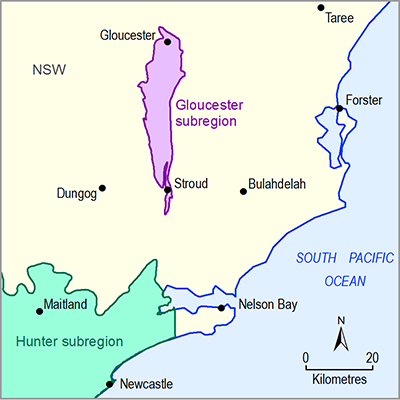For the Bioregional Assessment Programme, a chain of groundwater and surface water models is developed to probabilistically estimate the hydrological change due to coal resource development in the Gloucester subregion. The regional-scale analytic element groundwater model of the surface weathered and fractured rock layer, the alluvial groundwater models of the Avon and Karuah systems and the Australian Water Resource Assessment Landscape module (AWRA-L) surface water model are tailored to maximally exploit the relevant temporal and spatial scale and are designed to be conservative, that is, the models overestimate the hydrological change rather than underestimate the change.
The simulations indicate that it is unlikely for the drawdown due to additional coal resource development to exceed 1 m at receptors in the surface weathered and fractured rock layer. In the immediate vicinity of coal mines, less than 1 km from the mine footprint, larger drawdowns may be realised. The year of maximum change increases with increasing distance to the mine footprints. This also means the largest drawdowns due to additional coal resource development occur within or shortly after the active mining period.
At receptors in the alluvium, it is unlikely for the drawdown due to additional coal resource development to exceed 0.2 m. In the Avon alluvium adjacent to the proposed Rocky Hill Mine Complex there is a non-negligible probability of drawdown due to additional coal resource development exceeding 0.2 m. The median year of maximum change at the receptors occurs in the decades after mining operations in the subregion are planned to cease.
The effect of coal seam gas depressurisation and the effect of faults as conduits to propagate depressurisation to the surface weathered and fractured rock layer is not distinguishable from the effects of coal mining.
From the sensitivity analysis, it is apparent that the drawdown predictions are most sensitive to the hydraulic properties of the surface weathered and fractured rock layer. The qualitative uncertainty analysis highlighted that the mine dewatering pumping rates are crucial to the predictions. The model choices and assumptions, such as the hybrid modelling approach and the representation of surface water – groundwater interaction, are shown to be conservative. Despite this conservative modelling approach, the predicted hydrological changes are in line with those predicted in earlier local modelling efforts.
The modelling framework is tailored to the specific coal resource development pathway and receptors and therefore should not be used for any other purpose without a rigorous reassessment of the validity of the model assumptions. The modelling did highlight that improved characterisation of hydraulic properties of the surface weathered and fractured rock layer and more detailed information of local geology around baseline and additional coal resource developments have the most potential to reduce predictive uncertainty.

Product Finalisation date
- 2.6.2.1 Methods
- 2.6.2.2 Review of existing models
- 2.6.2.3 Model development
- 2.6.2.4 Boundary and initial conditions
- 2.6.2.5 Implementation of coal resource development pathway
- 2.6.2.6 Parameterisation
- 2.6.2.7 Observations and predictions
- 2.6.2.8 Uncertainty analysis
- 2.6.2.9 Limitations and conclusions
- Citation
- Acknowledgements
- Currency of scientific results
- Contributors to the Technical Programme
- About this technical product
